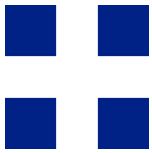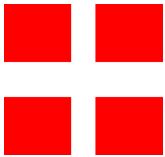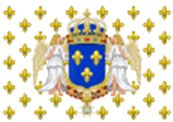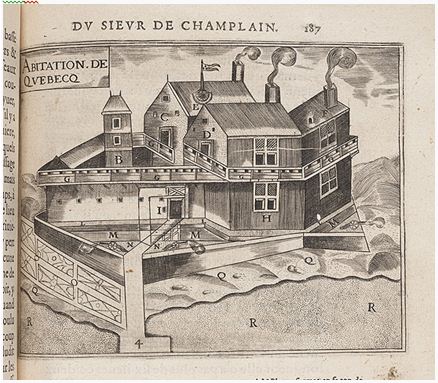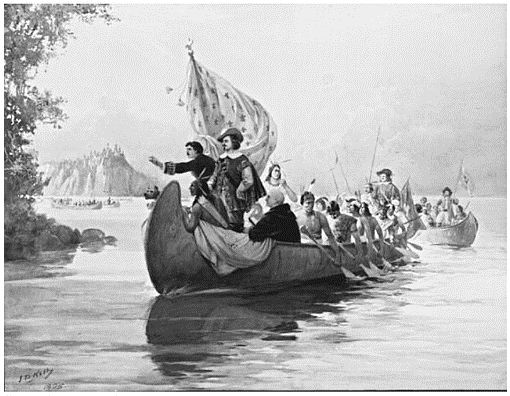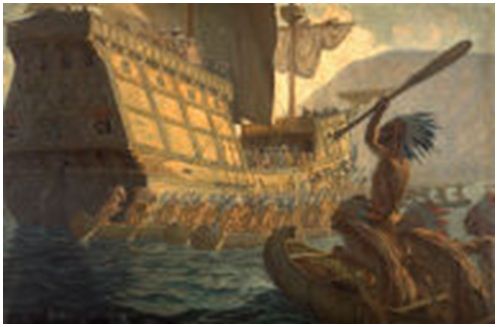Champlain’s Flags
In establishing its presence on the coasts of the Maritimes and along the St. Lawrence River, France was attempting to involve itself in the European competition for colonial empires in the new found land. By the beginning of the seventeenth century France had made significant progress toward asserting its influence in this part of North America.
Samuel de Champlain is considered to have been the Father of New France. His initial attempt at colonization at Port Royal, as well as his subsequent efforts at Quebec, and his penetrating exploration of the interior territory beyond Quebec, all support the understanding of Champlain as nurturer and patron of the fledgling, transplanted French settlement.
Champlain would have carried with him the new flag of France, which was blue with a white cross.
It had replaced the first national flag, which was red with a white cross.
Cartier would have flown the red flag as part of his voyages and explorations in the first part of the sixteenth century. Since Champlain was employed by a company of merchants, the Canada and Acadia Company, he flew the blue flag, a practice that was later confirmed by a 1643 treatise on hydrography that stated that merchant ships must carry the new colours. The King’s fleet at this time began flying the all white “La Marine Royale” flag as a result of the 1661 order of Louis XIV. This flag appeared in New France with the first of the King’s soldiers in 1665. In the presence of the King, the white flag was adorned with as many as 50 gold fleur-de-lis.
Cartier would have flown the red flag as part of his voyages and explorations in the first part of the sixteenth century. Since Champlain was employed by a company of merchants, the Canada and Acadia Company, he flew the blue flag, a practice that was later confirmed by a 1643 treatise on hydrography that stated that merchant ships must carry the new colours. The King’s fleet at this time began flying the all white “La Marine Royale” flag as a result of the 1661 order of Louis XIV. This flag appeared in New France with the first of the King’s soldiers in 1665. In the presence of the King, the white flag was adorned with as many as 50 gold fleur-de-lis.
There are many illustrations and paintings of Champlain’s early colonization efforts. Some are quite accurate, while others have details that are refuted by historical facts. One of the earliest renditions is by Champlain himself. He shows a swallow-tailed pennant of the royal banner of France flying from the highest roof top of the Habitation at Quebec in 1608. The royal banner is a blue field with three staggered gold fleur-de-lis.
The Illustrated London News, August 8, 1908 edition depicts the arrival of the reconstructed Don de Dieu at Quebec. The illustration shows Champlain’s ship flying the blue merchant flags from two masts.
The ensign flown from the quarter deck at the stern seems to be the solid white flag used by the Crown. This would appear to be an error in that the ‘drapeau blanc’ flag was not flown at sea until the royal order of 1661.
J.D. Kelly in his 1895 painting shows Champlain’s arrival at Quebec in 1608. This painting has also been titled “Samuel de Champlain in Georgian Bay C1615” and also “The Discovery of Lake Champlain 1609.” Regardless of the title, Kelly presents, quite clearly, the ‘drapeau de royaume de France’. Again this rendition runs contrary to the 1665 introduction of this flag to Canada.
J.D. Kelly in his 1895 painting shows Champlain’s arrival at Quebec in 1608. This painting has also been titled “Samuel de Champlain in Georgian Bay C1615” and also “The Discovery of Lake Champlain 1609.” Regardless of the title, Kelly presents, quite clearly, the ‘drapeau de royaume de France’. Again this rendition runs contrary to the 1665 introduction of this flag to Canada.
George Agnew Reid’s 1909 painting titled “Arrival of Champlain at Quebec” shows no flags in that the stern and its ensign are not in the illustration. In this way Reid was safe in not offering any historical inaccuracies. Champlain and those who have illustrated his exploits in New France have provided an interesting array of banners that highlight the evolution of the national flags of France up to the period of the establishment of a royal province by Louis XIV in 1663.
